I never meant for it to happen. I had absolutely no idea when I took down my own professional websites nearly a year ago, and when I erased all of my LinkedIn profile, and changed the name on it to Al Smith, 6 months ago, that I was, in fact, executing the conditions for a controlled experiment, which would reveal that LinkedIn sends out fake messages from corporate to its members, in order to manipulate and deceive people into thinking they have been contacted by professional people interested in networking with them. Furthermore, I had no idea LinkedIn was basically a front for gathering free email contact info, which is then sold to online marketing companies and junk mail houses granting them access to opt-in email lists with names of professionals, more and more of whom are actually only high school and college students, for the better part of $3.6 billion a year. I had no idea - but I do now.

If any of my readers own Microsoft stock, you might want to consider selling it until it no longer owns LinkedIn because LinkedIn is not what it appears to be. If I figured it out, then it’s only a matter of time until some other person figures it out, and the dominos start to fall. Before too long, LinkedIn is going to transmogrify into StinkedIn, and in this post, I am going to explain to anyone who cares, in no uncertain terms, exactly how I accidentally stumbled across this information.
Before I get started, let me ask you something. As a professional, when it comes to how you make your money, if you wanted to meet like-minded professionals, or if you needed the services of some other professional, would you ever start searching through millions of LinkedIn profiles to find someone that looked like they might be worth talking to or might be proficient at the service you needed? Would it ever even occur to you to engage a random search of millions of random LinkedIn profile pages, just hoping to find one good enough, so you could make a cold call invitation trying to meet them, and just hoping that it would soon all work out?
The answer is No. You know why? Simple. Because hope is not a strategy. Because it would not be a professional thing to do. Because there is no professional that operates like that. Because doing random searches to meet random people online, and hoping it will soon work out the way you want it to, for any reason at all, is about as sleazy as meeting random people in a bar in San Francisco’s Tenderloin District, and hoping it will soon all work out the way you want it to. Networking is not the same thing as cold-calling. They are qualitatively distinct. On the third rock from the sun, only low-level salespeople even make cold calls.
In short, no professional in their right mind ever has or ever will do that. Did you ever use LinkedIn for professional social networking? Do you know anyone who has? Have you ever even heard of anyone who has?
** *** **** ***** ****** ******* ******** ********* ********** ***********
My memory is not clear on exactly when I joined LinkedIn. It must have been 2008, 2009 - maybe 10? The only thing I remember about signing up is that you have to fill in all the blanks on your page to create your own profile, but there was only one blank for first name and one blank for last name. I’ve been called many things, but as a professional on the new social networking site for professionals, I wanted be the one and only Dr. Alex Durig. But, they had no space for the doctoral title.
Interesting choice on their part. Everyone looks the same on LinkedIn at first blush. For one Camelot moment, you can dream that you have equal standing with wealthy Arab sheiks and brilliant Indian CEOs.
That might work for everyone else, but as an obstinate contrarian, if the herd zigs, I have to zag. I wanted to be Dr. Alex Durig on my own professional profile page. So, I found a way. I just put Dr. Alex as my first name. For a few years, I was Dr. Alex Durig on LinkedIn.
But, the whole time, the worm was turning.
As the years went by, I could not help but notice that I hardly ever went there. I never used it, never went to my page, and it was basically pretty useless. I would often get messages like this.

Finally, after a few years, in 2014, my own orneriness began to get the better of me. It is funny to think about it now. Here is what happened.
One day, in 2014, I got an email from my friends at LinkedIn. It said that they wanted me to reset my password, and that I had to log in and create a new password in order to keep using it.
... and what if I don’t?
I mean, since when did LinkedIn decide they were going to give Me some work to do for them? As a liberated, modern individual, when did I sign away the sanctity of my own personal sovereignty and the privilege of running my life or messing it up, any way I darn well please?
Listen, I really resented the way they did that. My online bank doesn’t even treat me like that. I took it personally. They were messing with me. They were trying to control me. I was having none of it.
If I dutifully logged in and proceeded to change my password, like they they were telling me I had to, then they would own a tiny little piece of me, my volition, my decision-making ability, my time, my energy.
Besides, why would anyone hack into my LinkedIn profile?
Well, now I understand that from the standpoint of LinkedIn, the hacking threat is very serious. In retrospect, they were not out to help me to protect myself - they were out to help me protect their own Intellectual Property (IP). What IP could LinkedIn possibly own?
Namely, my email contact info and my professional profile. You see, it’s their most precious IP, because they sell it to online marketers and junk mail houses in the form of email marketing lists - it’s how they make their money. It’s the real purpose of LinkedIn. So, they are afraid of someone hacking their system, stealing my info and everyone else’s, and then pirating it to online marketing companies because that would ruin the way they make most of their money.
But, I’m getting ahead of myself - at this point in the story, I resented being told to change my password. It was like being told to take a shower. That’s personal. I decide when to take a shower.
Well I know it wasn't you who held me down
Heaven knows it wasn't you who set me free
So often times it happens that we live our lives in chains
And we never even know we have the key
I was finished with LinkedIn. I decided to never even go back to change the password - I was already gone.
** *** **** ***** ****** ******* ******** ********* ********** ***********
Life went on, and for two years I never thought about you-know-what unless I got one of those pesky little emails. You know the kind. You’ve been getting them, too.

Every once in awhile, some unknown person would message you that they would like to join your LinkedIn network for up-and-coming social networking professionals who are in the know and on the go. Right?
You never knew who those people were. You never really cared too much either, did you? You just figured that was the nature of the game.
It’s a numbers game right? You put yourself out there because ... well, because everybody’s doing it, right? It’s the in, hip, cool thing to do. You put yourself out there, and everybody in the whole world can see you, and one never knows what could happen. Right? It’s the exciting new world of professional social networking, and we all decided to get in on the ground floor.
You know why? Because we all thought everyone else was getting in on the ground floor, and no one wanted to look like the lone fool who didn’t get in.
That’s what you thought. That’s what I thought. That’s what everybody we knew thought.
And this is exactly what all 89 kajillion people who joined LinkedIn thought.
In the words of Hannibal Lecter, it seemed like a good idea at the time.
Besides, it was free. They had this special premium version you had to pay for - but what could possibly be so incredibly special about it?
Is it that the freemium version is where people can find you, but, like, the special premium version is where people can really, really find you? Whatever ...
Once I had a sheik from Dubai contact me and want to be a part of my network. I was excited. He was smarter than the average sheik. That was immediately obvious to me. But, when I sent him a message, he never even wrote me back.
It was of little consequence to me because ... I never used it anyway. Not once in all those years did anything ever happen on my LinkedIn page that enhanced my career in any way shape or form.
As time went by, I forgot that I had forgotten about LinkedIn, you know what I mean? I got so used to receiving those inane little emails that I just glossed them nonconsciously, never even giving LinkedIn a second thought.
And you know what? I bet you did the same thing.
You got so used to getting their inane little emails every once in awhile that your eyes would just gloss over them most of the time, right?
Understand something. This story is not just about me. This story is about you, too. Anybody else reading this post who has been a member of you-know-what should be nodding their head while reading this post, recognizing all the same inane little things happened to you.
It’s as if in life, we all have our own unique journey with LinkedIn, but in reality, it turns out, all of our journeys have actually been quite the same.
** *** **** ***** ****** ******* ******** ********* ********** ***********
Fast forward to 2016 - two years later.
I don’t know why - for some reason I took notice again of the sheer uselessness of the site, of the fact that I had never used the site at all, of the fact that I had been ignoring the site for two years now, and without being able to explain it, I got tired of ignoring LinkedIn.
I wanted to confront LinkedIn. Have it out.
And suddenly, I knew it was time.
I was going to break up with LinkedIn, for good this time.
No more pesky emails.
You see this whole time, I knew there was a way to delete your LinkedIn account, but the point of my game was not to even change the password, remember? Therefore, I could not get in and delete the account. My stance was that I cared so little for the site, that I did not even need to delete it - it was already deleted from my radar.
Well, after two years, something was stuck in my craw and I found myself having a talk with myself. I realized that it was just time. It was time to log on to LinkedIn, and change my password as they had ordered me to two years earlier. But, this time, I would summarily proceed to that delete-account page, and be done with it, once and for all.
What happened next left me nonplussed. After going through all the dreaded motions, they had changed things in the last two years - there was no longer any way to delete my account.
What?
Please do not even think of telling me there is a way, that I just could not find it. There has never been anyone who wanted to delete their LinkedIn account more than I did in that moment. Trust me - I looked and looked and looked - I could have found the lost city of El Dorado with less effort - they had completely obfuscated that option.
Dumbstruck. Speechless. Were they actually that hell-bent-for-leather on controlling me that they would not even let me delete my own account now? Do they think they will possess my online LinkedIn profile page forever and there is not a thing I can do about it?
Dear Goddess Above: You have got to be kidding me.
They think they own my name online, and when it comes to my professional reputation and image online, and when it comes to the cool new world of professional social networking online, they actually think they own my name.
When it comes to my identity, and specifically when it comes to that LinkedIn profile page with the one and only Dr. Alex Durig professional profile - they think they own that online real estate. They think they own it outright, and there is nothing I can do about it.
It seemed particularly bold because I had long known how utterly useless they were. I never heard of anyone talking about the success that had come to them through LinkedIn. Never heard of anyone having their career enhanced because of being on LinkedIn - where all the action is.
It’s the place where everyone who’s anyone wants to be seen.
Specifically, here is what happened next. I thought about it for awhile, and then it hit me. Since I could not find the delete-account page anymore, I suddenly decided to see if I could just delete all the info in the boxes of my page. That had to be possible because fooling with the boxes is how you create your stupid, useless profile in the first place.
You do all the work for LinkedIn, you make up your own profile, and then your page just sits there. The people at LinkedIn don’t even do anything - do they? What do they do?
So, I went all the way down to the bottom of the page, I went to the very last box, I deleted all the info in the box, hit the save button, and waited to see what happened next.
Bingo - it saved the box as empty. Now, all I had to do was go into every single box, delete all the content, and in a matter of seconds, I would have effectively deleted my LinkedIn page, once and for all. Psyched - I started busily deleting content and working my way up to the first boxes at the top of the page - the holiest of holies, those two name boxes - where it had all begun, lo those many years ago.
And you will never guess what happened next.
When I got to the name boxes, and set out to delete Dr. Alex - it would not let me delete my own name.
Oh, no it did-n’t.
Oh, yes it did.
Ok, now I was officially involved. Yeah, sure, it was all a silly, pointless game until now - a silly, pointless little game. But, don’t try to pretend like you own me - you don’t own my name - you can own your own site, but you can’t own my name on your site.
Now what am I going to do, darn it?
Thinking, thinking, thinking ...
And then ...
Idea ...
What if I replace my name with another? Yeah. It wants this page to stay here, owned forever, and it will let me delete anything in those boxes, and leave them blank, but it will never let me delete my one and only Dr. Alex Durig name and leave the boxes blank, so what if I changed my name ... to something innocuous like ... say ... Al Smith?
And that is exactly what I did.
First name = Al - save out.
Second name = Smith - save out. And done.
That is how I won. I was more than satisfied. The war was over.
The battle had been hard fought, and I had won. LinkedIn had tried to own me, own my professional image online, they even had the temerity and the bold bad form to try to own my name forever - that was a mistake. They had challenged my individuality, I went to war. I fought the good fight, and I had won. Sun Tzu would be proud.
Sun Tzu said the essence of warfare is deceit.
And now for the rest of my life, once a month I knew Al Smith would be receiving an email from LinkedIn saying:

LinkedIn makes a big deal about how their business is dedicated to helping professionals find jobs.
What jobs? Didn’t they get the memo? There are no jobs. It’s not like LinkedIn is some kind of magical oasis in the desert of our economy.
Sure there are, of course, there are 15,000 jobs near me - sitting here on Oak St. in the middle of downtown Louisville, Kentucky. I can see them all now, from my living room window, right across the street, standing on the street corner, waiting for someone to swing by and pick them up, while their pimp, LinkedIn, looks on from a few doors down. And because LinkedIn decided to pimp out America’s cornucopia of jobs, I can have the very best one. And I’m truly grateful for that.

Of course, it would be just another LinkedIn lie - the same kind I had been receiving in my inbox for all of these years from these hucksters of silicon soul - but from now on, every time I saw it, I would chuckle to myself, wryly.
I win.
** *** **** ***** ****** ******* ******** ********* ********** ***********
Everything I knew about life told me that was the end of my banal, errant encounter with LinkedIn. No one would ever know. And I would always be tickled when the next LinkedIn email arrived and announced to Al Smith that there were 15,000 jobs near him.
It didn’t take long before I started recieving Al Smith’s emails. It doesn’t take much to amuse me.
Even though I had deleted every piece of information - it still kept sending Al Smith’s LinkedIn emails to my deleted email address.
LinkedIn is some piece of work alright. It’s actually a piece of persnickety coding.
You have to believe I would have been too embarrassed to let anyone know about the quixotic quest I had been on - how I had spent two years of my life actively ignoring it, and then decided to engage the LinkedIn Windmill Monster, do battle, and slay it once and for all. When I dream impossible dreams, and battle cosmic windmill monsters, I always keep it to myself.
No, that one was just for me - and no one would ever know. My authority defiance syndrome is my own business, and I would never knowingly visit it upon an innocent person for any reason.
As I write, it is early February of 2017. It’s been a lifetime since I first joined LinkedIn, 2 1/2 years since I first decided to divest myself of it, and 6 months since one Dr.Alex Durig had disappeared forever from the owned online real estate of that piece-of-tripe site.
And then it happened. The other day, the strangest thing happened. This is so good that I am going to share it - all of it - with all of you. You have to believe this is true. I could never make this story up. I’m just not that good.
Only the unique combination of a dishonest professional networking site, and a contrarian writer with a quixotic authority defiance syndrome who doesn’t know how to leave well enough alone, could come together to result in what happened next in this story.
I did a search on LinkedIn in my Inbox, and here is my LinkedIn history with the latest message I received from LinkedIn this morning, on top, and under it is the message I received last Friday, February 3, 2017.

When you open the top message, you can see how it is addressed to Al Smith, but using my email - alex@phd-businessplan.com.

And now, for the pièce de résistance ...
Read it and weep - weeping tears from laughter so hard that your stomach hurts and you have to bend over praying that you’ll stop laughing soon because it hurts so much. Here is the email on the bottom, from you-know-who, Mayank Jain, CEO of Prologic:
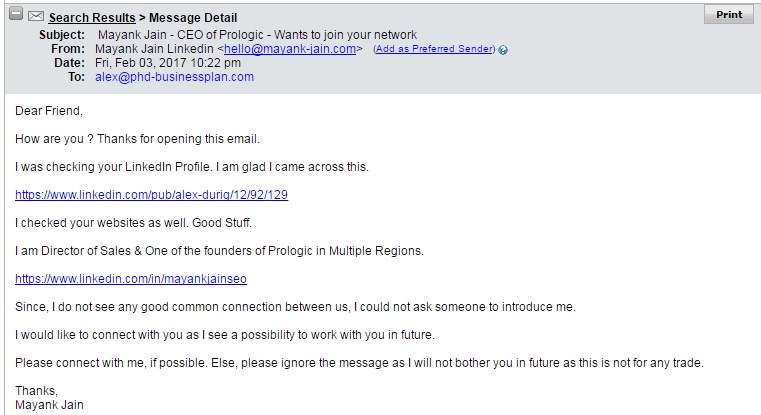
Ok, let’s evaluate what just happened.
Who is this Mayank Jain, CEO of Prologic?
Either he does not exist, and the brilliant staff at LinkedIn made him up, just concocted him in an attempt to deceive me into engaging the site because I might now think it is finally working the way it was supposed to all along;
Or
He, himself - Mayank Jain, CEO of Prologic - is one of the wealthy VC investors who founded this spawn-of-satan site and therefore may own Microsoft stock and he has allowed the brilliant staff at LinkedIn to use his name in order to deceive me, and manipulate me into hoping against hope that the site really does work every once in awhile the way the whole world thought it was originally supposed to.
My guess? I will tell you one thing for certain, right now: I have absolutely no idea what is going on in these people's heads. All I know is that this email is completely fake - it was engineered to impress me ... and it has been almost a week now, and I still haven't stopped laughing ...
2. See where the message says that he, Mayank Jain, likes my profile?
Well, my profile has not been up for 6 months, folks. He even gives a link to show me the info he has just perused, but, folks, when you click the link and go there - it is a blank page. See?
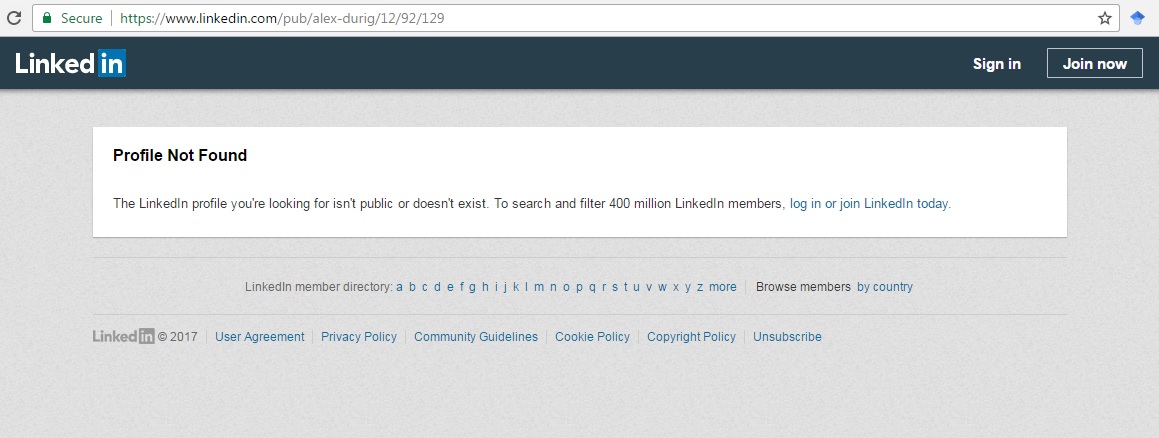
So, no human just went there and saw anything. No human with a functioning brain just visited this site and wrote to tell me how fascinating it is.
Which means some idiot programmer must have coded an email that included a link to profile page information - it must have been a coded email function targeting people who have not used their site for a while.
Pretty smart, huh?
The only problem for them is that the idiot programmer who coded the idiot email I received neglected to consider I might have deleted every single bit of information on my profile page, changed my name to one Al Smith, and shut down my professional sites long ago. They obviously assumed that they had ensured no one would be able to delete their profile page, so their coded email was designed to impress me based on the assumption that no one can delete their useless profile page anymore, so I would be glad to receive attention on LinkedIn from one of the beautiful people - namely, one Mayank Jain, CEO of Prologic.
Historically, more than 3 out of 4 people who sign up for their LinkedIn profile page, quit using it. That’s a horrible statistic for them, and no doubt, why they decided to begin preventing people from deleting accounts. LinkedIn mistakenly assumed that everyone would just learn to live with the new ring in their nose - the new ring that was attached to a cord, that was controlled by LinkedIn, and which they assumed they could yank on anytime they wanted to get a reaction out of us.

3. See where my new social networking buddy, Mayank Jain, CEO of Prologic, says he even looked at my websites?
Well, those have been down for almost a year now, Mayank. How could he have just looked at them? My main site for over ten years has always been PhD-businessplan.com - and I had another writing site of mine attached to it, so anyone visiting one would also visit the other - until about a year ago. However, I have not had those sites up for nearly a year because the business plan business died on the vine three years ago.
Anyone can check a website’s historical presence online for any day going as far back as one desires. Anyone can see that my sites have not been up for anyone to read for nearly a year, and anyone can see that my LinkedIn account has been cleaned out with nothing left on it, but the name Al Smith, for 6 months now.
Mayank Jain, CEO of Prologic, did not just see my LinkedIn Profile.
Mayank Jain, CEO of Prologic, certainly did not just visit my websites.
This is all a lie - concocted - you guessed it - by LinkedIn.
LinkedIn is a scam, folks, and it has been since Day 1. It is all quite obvious now. Let’s just air it all out for the sake of letting in some sunshine to this moldy, dark place called LinkedIn because sunlight is always the best disinfectant.
Mayank Jain also provided me with a link to his LinkedIn site - would you like to see it?
Here is the first view after clicking the link:
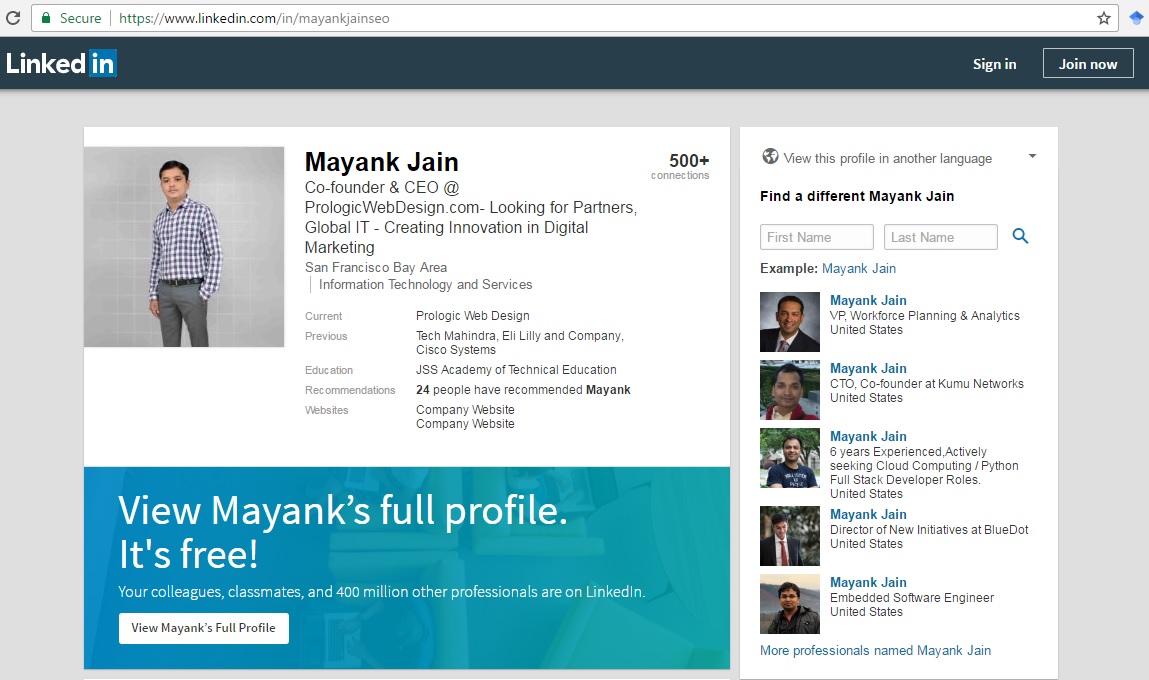

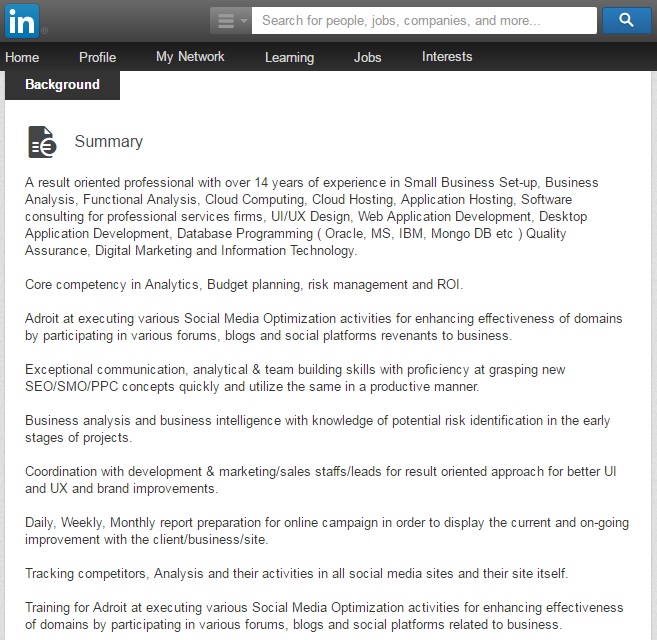
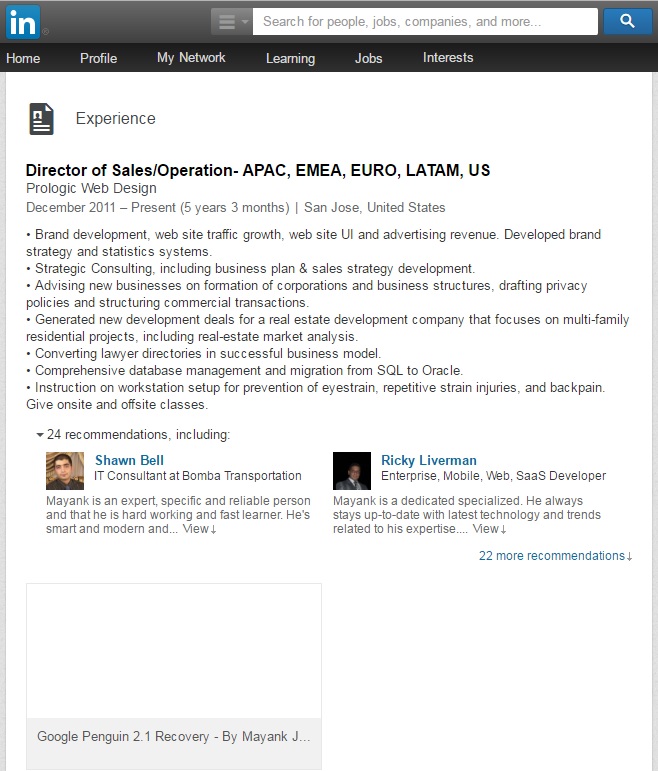

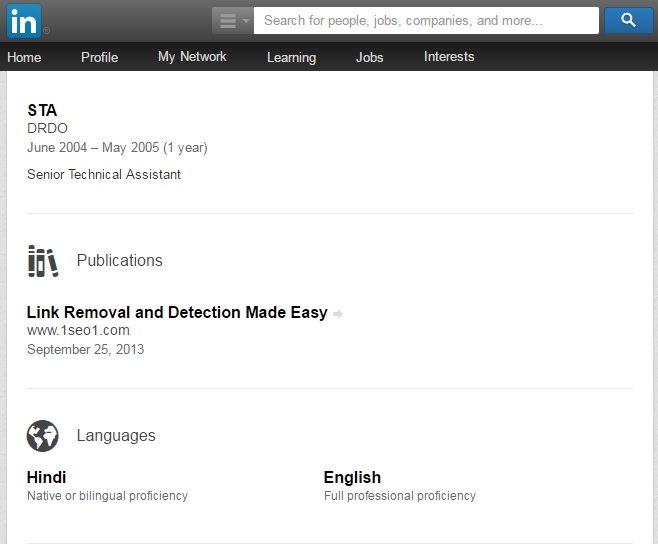

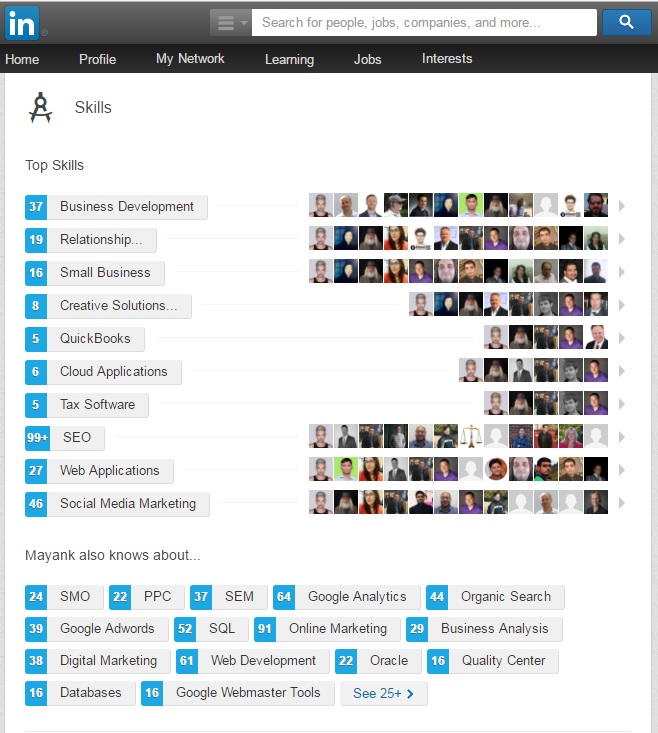
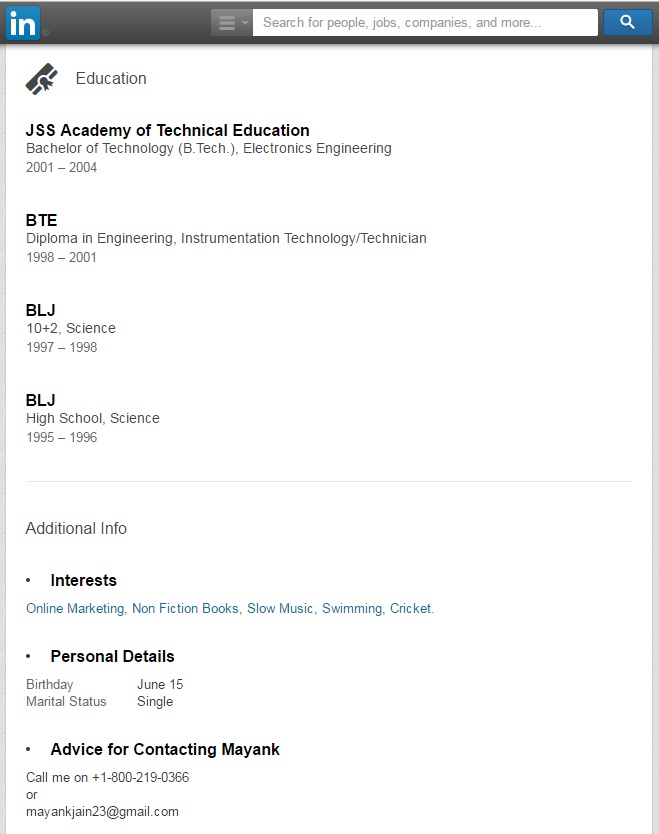

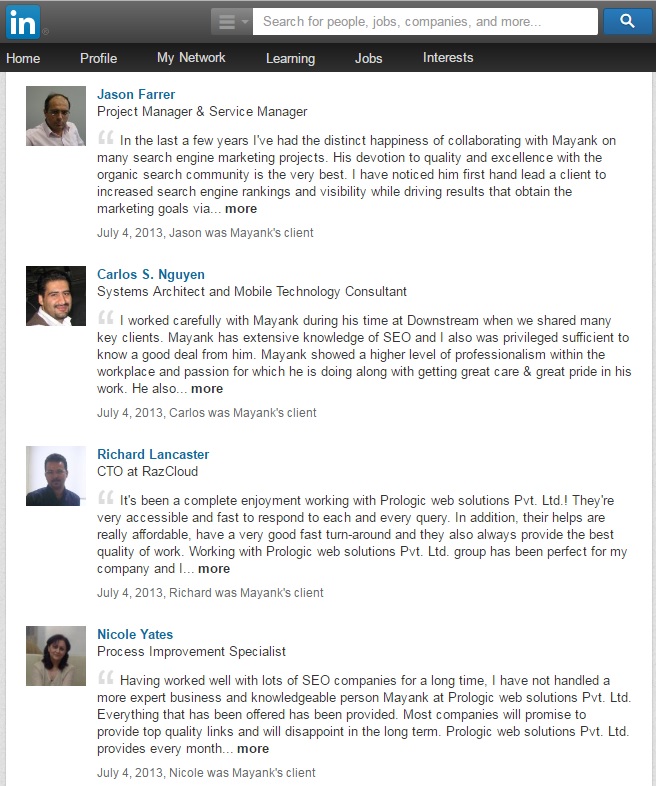

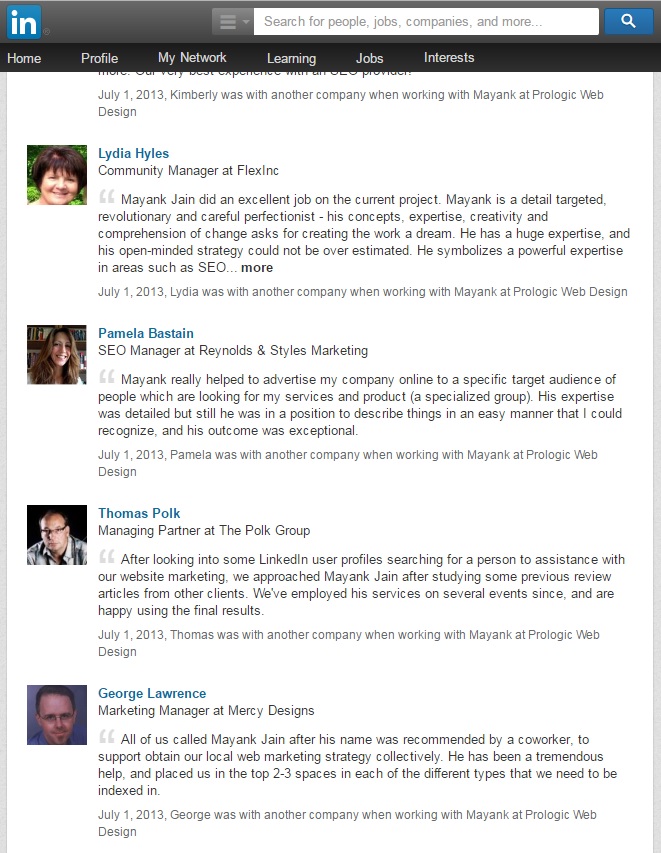
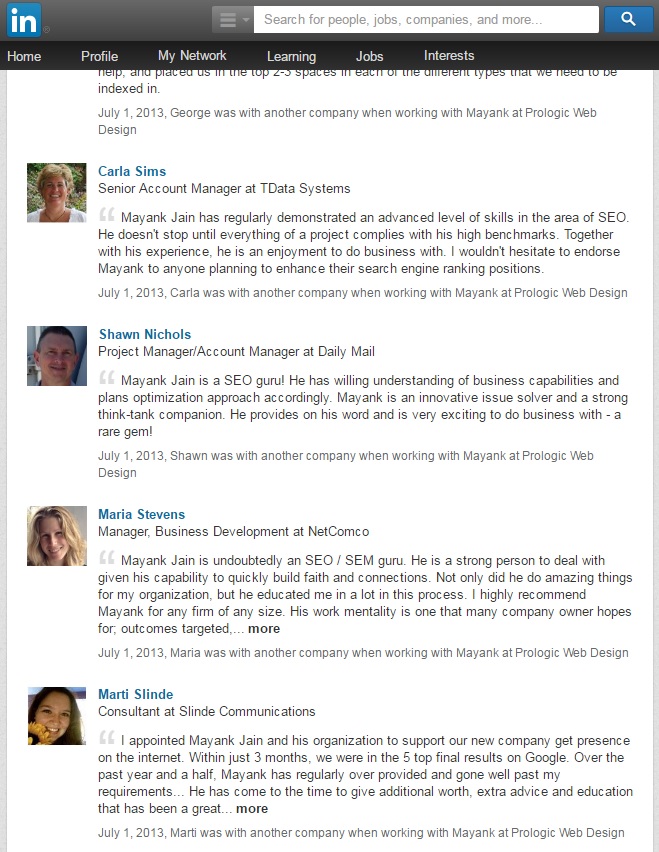
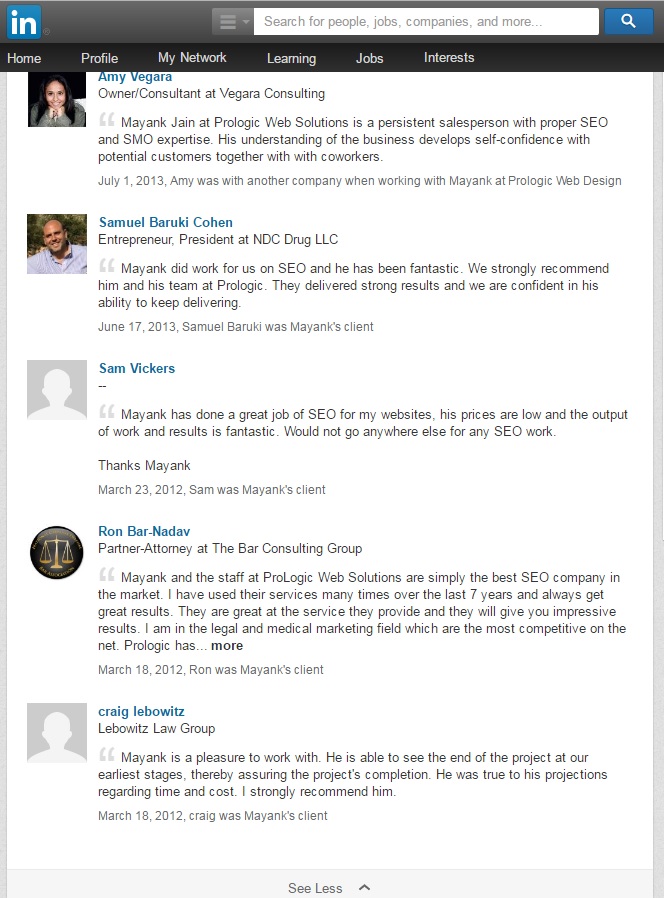
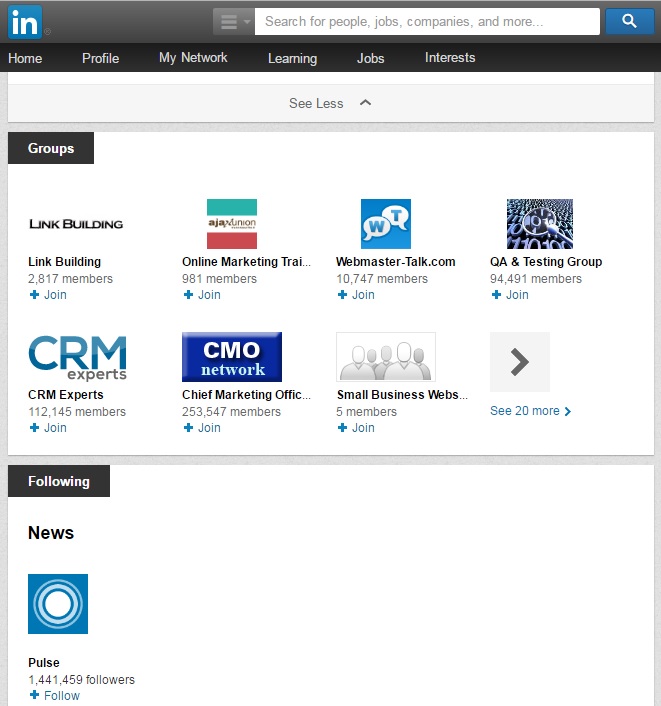
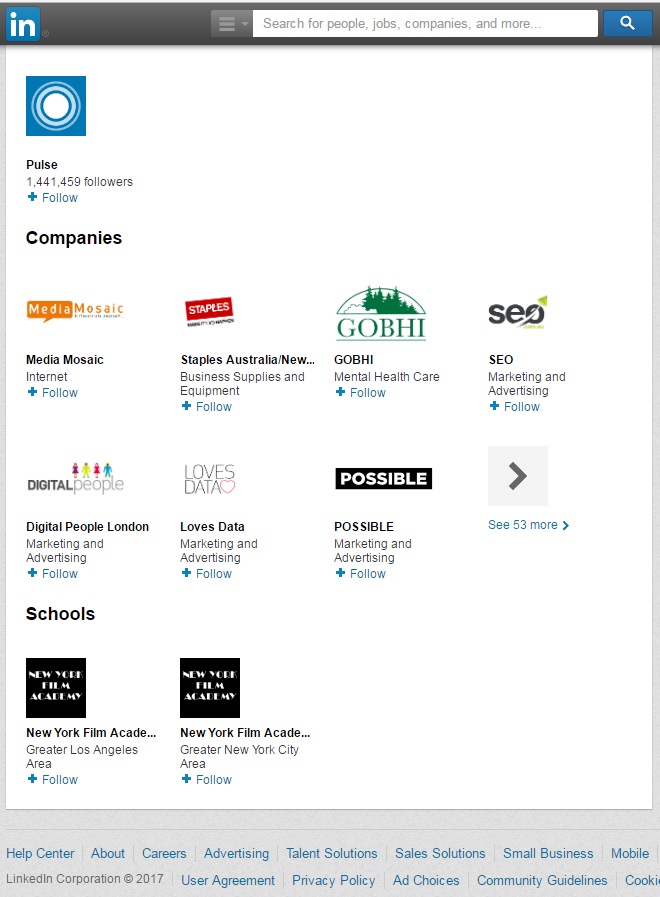
That is quite an effort for a fake profile, isn't it?
If it is not fake, and if Mayank is real, and if he himself did not send it or authorize it to be sent, then Mayank has one helluva lawsuit on his hands. If he has any class at all, he'll make it a class action suit and include me in it.In fact, if any of those people in his references section are real, they might have one helluva law suit on their hands. It just occured to me that if any of these folks have any class at all, they could make it a class action law suit and include me in it. It wouldn't be the first class action lawsuit LinkedIn has lost.
** *** **** ***** ****** ******* ******** ********* ********** ***********
Now, this is the beginning of the Wikipedia page for LinkedIn. Even just after briefly perusing my post, you will immediately be able to identify this site for the scam it has been perpetrating all these years. Incidentally, you can be sure they authored their own Wikipedia entry. So, from the first sentence, this company description is a classic.
LinkedIn (/ˌliŋkt.ˈɪn/) is a business and employment-oriented social networking service that operates via websites. Founded on December 28, 2002, and launched on May 5, 2003, it is mainly used for professional networking, including employers posting jobs and job seekers posting their CVs. As of 2015, most of the site's revenue came from selling access to information about its users to recruiters and sales professionals. As of September 2016, LinkedIn has more than 467 million accounts, out of which more than 106 million are active. LinkedIn allows users (workers and employers) to create profiles and "connections" to each other in an online social network which may represent real-world professional relationships. Users can invite anyone (whether a site user or not) to become a connection. The "gated-access approach" (where contact with any professional requires either an existing relationship, or the intervention of a contact of theirs) is intended to build trust among the service's users. LinkedIn participated in the EU's International Safe Harbor Privacy Principles.
The site has an Alexa Internet ranking as the 14th most popular website (October 2016). According to the New York Times, US high school students are now creating LinkedIn profiles to include with their college applications.
Allow me to transliterate the above text from professional legalese to plain, old English, going line by line:
“LinkedIn is a business and employment-oriented social networking service that operates via websites.“ This amounts to infantilization of the audience, but I was flabbergasted to find out that the whole thing operates via these newfangled things called w-w-websites.
“Founded on December 28, 2002, and launched on May 5, 2003, it is mainly used for professional networking, including employers posting jobs and job seekers posting their CVs.” It is odd the way it says “it is mainly used for professional networking,” Using the word “mainly” implies there are all kinds of things happening there - but it’s not exactly known for being the Swiss Army Knife of web portals. How many things can you do anyway on a professional social networking site besides social networking, whatever that means, and tapping into the constant, unchanging presence of 15,000 new jobs, all near you, hovering right over your head, all the time?
“As of 2015, most of the site's revenue came from selling access to information about its users to recruiters and sales professionals.” Whoomp! There it is! And now we find out the truth, the whole truth about LinkedIn. Most people will have no idea what that means, so let me explain it in no uncertain terms. It means they admit to making most of their money selling your name to online marketing companies and junk mail houses so they can send you all that junk mail you get, which leaves you always wondering where it all comes from, and how they got your email in the first place. Do I have your attention now? They sell our names and contact info to online marketers and junk mail houses in the form of opt-in email lists of professionals with every talent and interest they could want to sell to. They have surreptitiously obtained our opt-in permission because when we joined, we implicitly gave them our name, our first born, and our soul, to do with as they pleased - it was finagled in the fine print. The headquarters of LinkedIn are in Sunnyvale, and one of the largest junk mail houses in the country is located nearby in Mountain View, California, where LinkedIn was launched - and both places are not far from Silicon Valley. I know this because every time I have to block the latest piece of neverending junk mail to hit my inbox, it almost always comes from Mountain View, California. Coincidence?
“As of September 2016, LinkedIn has more than 467 million accounts, out of which more than 106 million are active.” I think that one speaks for itself - most people who start using it, stop using it. See? I’m not crazy.
“LinkedIn allows users (workers and employers) to create profiles and "connections" to each other in an online social network which may represent real-world professional relationships.” Once you see the deception of LinkedIn, you cannot un-see it. What do they mean by the phrase “which MAY represent real-world professional relationships” ?? Allow me to transliterate: they mean “which may not represent real-world professional relationships.” You see, that is legalese for this whole company is a scam that guarantees nothing, for the simple reason that everything that happens to you on LinkedIn may not actually represent anything real at all - never did, never will. It’s just a big scam to get names and email addresses of professionals, and students who are wannabe professionals, for the purpose of selling access to online email and junk mail marketing lists. They admitted it when they said that was the main source of their $3.6 billion dollar annual revenue.
“Users can invite anyone (whether a site user or not) to become a connection.” Wo-o-o-o-ow, what will they think of next? This is baby-pablum talk in the name of high-tech sophistry and it amounts to more infantilization of the audience. In other words, they think we are all completely and totally stupid. More perfunctory BS.
“The "gated-access approach" (where contact with any professional requires either an existing relationship, or the intervention of a contact of theirs) is intended to build trust among the service's users.” I would never use the words trust and LinkedIn in the same sentence - ever again. More fancy BS.
“LinkedIn participated in the EU's International Safe Harbor Privacy Principles.” Who cares about EU bureaucracy? Anybody? Maybe the Brits? More fancy, worthless BS.
“The site has an Alexa Internet ranking as the 14th most popular website (October 2016). According to the New York Times, US high school students are now creating LinkedIn profiles to include with their college applications.” It is actually better than that - university professors in business schools around the country are now spending inordinate amounts of time teaching their students how to set up their own LinkedIn pages. How much education does it take to do this anyway, folks? You fill in the blanks with your name in the name box, and your education in the education box, and so on. They could teach LinkedIn to children in kindergarten, for crying out loud. Since when does it take a college professor to teach LinkedIn? I hate to say it, but that only indicates too many college professors are about as silly and pointless as LinkedIn. How much money have parents paid to have their kids learn from bonafide PhDs, housed in the colleges of business around the nation, all about the virtues and vicissitudes of creating a lousy LinkedIn profile page?
Ok, students, see the name box? Now, that’s where you put your name. Now, pay attention, because you will be tested and graded on this, and it will become a part of your permanent record that will follow you around for the rest of your life - just like your LinkedIn profile.
** *** **** ***** ****** ******* ******** ********* ********** ***********
Now check this, also from the Wikipedia page for LinkedIn:
LinkedIn is headquartered in Sunnyvale, California, with offices in Omaha, Chicago, Los Angeles, New York, San Francisco, Washington, Sao Paulo, London, Dublin, Amsterdam, Milan, Paris, Munich, Madrid, Stockholm, Singapore, Hong Kong, China, Japan, Australia, Canada, India and Dubai. In January 2016, the company had around 9,200 employees.
Now, notice these things from the above passage:
See how they have an office in Dubai? That makes me think about that networking request I received from that sheik, once upon a time. Now, I feel like I’m cooking with gas, and it makes me to wonder aloud: how many other people already have a friendly sheik in their LinkedIn network?
Now, see where it says that as of a year ago they had over 9,000 employees?
Well, what could 9,000+ people possibly be doing at LinkedIn?
What are they doing over there - splitting the atom?
Heck, there are only 2,250 full-time staff working at bloody CERN, for crying out loud.
I mean, you have to fill in your own profile, right? And then it just sits there. What in the name of God and Goddess could 9,000+ people possibly be doing over there at LinkedIn?
It defies logic.
Either, they do not have 9,000+ employees and they just say they do because the whole business model is premised on a big lie anyway, just getting people to think they are doing something so colossally important over there that it must matter, and gosh, everyone else is doing it, so it really does matter;
Or
They have some significant fraction of 9,000+ employees, because they do need people to help sending out all of those fake emails from Dubai sheiks and Mayank Jain, CEO of Prologic, and everyone else, in order to be giving the impression that there are indeed many noteworthy professionals genuinely combing the site doing random searches for professional LinkedIn folks every day.
They probably have programmers coding such emails to go out automatically once a user has not visited their profile for a certain amount of time, and they probably have individuals pretending to be individuals and sending out networking requests all the time. In other words, every day, in every way, they have to make thousands of people think that thousands of people are using the site every day - get it?
In other words, one of those 9,000+ employees probably just sent me that faker than fake, very obviously fake email request from one of the biggest LinkedIn losers of all time - I am talking about one Mayank Jain, CEO of Prologic, who just saw my profile page, and who really get’s me, and who just loved my websites, too, and he wants to meet me, he really does, he said so, and you can read it for yourself, and he thinks we might work together and everything - get it?
** *** **** ***** ****** ******* ******** ********* ********** ***********
There is one silver lining to the story - one thing I just found out that appeases my mood somewhat because it is a sure-fire sign of the imminent demise of LinkedIn: Microsoft just bought it. Personally, I am absolutely sure that LinkedIn and Microsoft deserve each other.
In the words of John Lennon, Instant Karma’s gonna get you - gonna zap you right between the eyes.
** *** **** ***** ****** ******* ******** ********* ********** ***********
Did you ever hear the story of Teddy Roosevelt and the bear? He was hunting, and he came across a bear that was all chained up. Instead of taking the easy kill, and looking brave in front of everyone when he arrived back at camp with the dead bear, he let the bear go. When the story got out, some enterprising person made a little stuffed bear to commemorate the occasion. They called it ... the teddy bear.

Well, what does the story of the teddy bear have to do with LinkedIn? The founders of LinkedIn, who happened to be among the wealthiest VC investors in America, in their own inestimable wisdom, shot the bear. They unloaded on the bear. They shot their wad on the bear. Then, in 2016, they sold the bear to Microsoft for $26.2 billion, which proceeded to eat the bear and consummate the largest single acquisition in its history. Ouch. This will surely be remembered as the largest single mistake in its history.
Only in America.
Maybe Microsoft is guilty of buying into LinkedIn, but it is increasingly obvious to me that from now on, fewer and fewer truly intelligent people will be. Professional networking just doesn’t happen on LinkedIn - it’s a myth, a mirage. Real social networking across the many worlds that professionals occupy is simply not the same thing as being on Facebook, only you’re doing it on LinkedIn. If you really think what you need to be successful in your career includes doing some professional social networking on LinkedIn, then I have some news for you. Real professionals do not routinely stake their careers on the chance of contacting random, unknown avatars online. That’s not real professionalism - that’s just real dumb.
** *** **** ***** ****** ******* ******** ********* ********** ***********
Well, that’s all folks - that’s all she wrote, as they say - and finally, we have come to the ignominious end of the LinkedIn story.
And you? Well, you can do whatever you want - but let me put it this way, and I mean this from the bottom of my heart: If your mom owns any Microsoft stock, help mom out because as long as it owns LinkedIn, mom should not be counting on a flimsy front for junk mail houses to sustain her in retirement. LinkedIn is not going to be a growing division of Microsoft 5, 10 or 15 years from now. It might not be worth anything 1 year from now. And don’t do it just because I said so - I might be wrong. Just consider for yourself whether you really want to gamble your mom’s retirement on the integrity of Microsoft stock as long as it owns LinkedIn. Help mom to sell her Microsoft stock now, and she’ll thank you when LinkedIn's fake business hits the real skids.
And me? I had no idea when I took down my sites a year ago, and when I erased all of my LinkedIn profile, and changed the name to Al Smith 6 months ago, that I was, in fact, executing the conditions for a controlled experiment, which would reveal that LinkedIn is the kind of site that sends out fake messages from corporate to its members, in order to manipulate and deceive people into thinking they have been contacted by someone prestigious and successful. I had no idea LinkedIn was just a scam front for gathering free email contact info, which is then sold to online marketing companies and junk mail houses granting access to opt-in email lists of millions of professionals, even though more and more of them are actually only students, for the better part of $3.6 billion a year. I had no idea - but I do now.
And Mayank Jain, CEO of Prologic? Well, he might not even exist. But, if he does, he might soon wish he didn’t, because the internet has a funny way of transmitting lurid news, and one day he might be known by everyone on the third rock from the sun as the biggest LinkedIn Loser of all time - besides Microsoft, that is.
And Al Smith? Well, it was Al Smith’s takeover of my LinkedIn profile page that really set the stage for outing the whole scam once and for all. LinkedIn never counted on Al Smith. Therefore, on behalf of myself and one Al Smith, both of us would like to invite everyone to delete all of your LinkedIn profile page info, and change all your names to Al Smith.
Besides your illustrious careers, what have you got to lose?
** *** **** ***** ****** ******* ******** ********* ~The End~



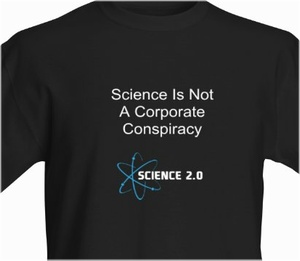

Comments